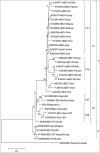Identification and characterization of a novel infectious bursal disease virus from outbreaks in Maharashtra Province of India
- PMID: 30532511
- PMCID: PMC6247889
- DOI: 10.14202/vetworld.2018.1516-1525
Identification and characterization of a novel infectious bursal disease virus from outbreaks in Maharashtra Province of India
Abstract
Aim: The study was undertaken to isolate infectious bursal disease virus (IBDV) from clinical cases in broiler and cockerel flocks of Maharashtra state, India, and its molecular epidemiological investigation.
Materials and methods: The morbid bursal tissues were collected from flocks suspected for IBD. The samples were subjected for virus adaptation in primary chicken embryo fibroblast (CEF) cells followed by confirmation by reverse transcription polymerase chain reaction (RT-PCR) for partial VP2 sequence and phylogenetic analysis.
Results: The isolation of IBDV from field samples took seven blind passages for adaptation in CEF. The cytopathic effects included rounding, aggregation, vacuolation, and detachment of the cells. The RT-PCR showed amplification of 627 bp amplicon specific to the primers for VP2 gene fragment which confirmed successful adaptation and isolation of IBDV using CEF. The nucleotide and deduced amino acids based on phylogeny clustered the current isolate in a distinct clade with classical virulent and antigenic variants. It showed divergence from very virulent (vv) and vaccine strains of Indian origin. The isolate showed unique amino acid substitution at A329V as compared to all other IBDVs. The variation in key amino acids was reported at A222, I242, Q249, Q253, A256, T270, N279, T284, I286, L294, N299, and V329. It shared conserved amino acids at position A222, I242, and Q253 as reported in vvIBDV isolates. However, the amino acids reported at position T270, N279, T284, L294, and N299 are conserved in classic, antigenic variant and attenuated strains of IBDV. The amino acids at positions N279 and T284 indicated that the isolate has key amino acids for cell culture replication.
Conclusion: The IBDV field isolate does not reveal the full nucleotide sequence signature of vvIBDV as well as vaccine strains. Hence, we can conclude that it might not belong to vvIBDVs of Indian origin and the vaccine strain used in the region. This may be suggestive of the evolution of the IBDV in the field due to the coexistence of circulating field strains and live attenuated hot strains, resulting into morbidity and mortality, warranting the need for safer protective vaccines, and implementation of stringent biosecurity measures to minimize loss to farmers.
Keywords: VP2; adaptation; chicken embryo fibroblast; epidemiology; isolate infectious bursal disease virus.
Figures






Similar articles
-
Genetic variability in VP1 gene of infectious bursal disease virus from the field outbreaks of Kerala, India.Trop Anim Health Prod. 2021 Jul 22;53(3):407. doi: 10.1007/s11250-021-02852-7. Trop Anim Health Prod. 2021. PMID: 34291320
-
Genetic characterization of Infectious Bursal Disease Viruses isolated from the vaccinated broiler chicken flocks in Egypt during 2015-2016.Pol J Vet Sci. 2018 Sep;21(3):581-588. doi: 10.24425/124293. Pol J Vet Sci. 2018. PMID: 30468343
-
Molecular characterization of field isolates of infectious bursal disease virus from three decades, 1987-2018, reveals a distinct genotypic subgroup in Vietnam.Arch Virol. 2019 Aug;164(8):2137-2145. doi: 10.1007/s00705-019-04287-w. Epub 2019 May 20. Arch Virol. 2019. PMID: 31111260
-
Antigenic and molecular characterization of recent infectious bursal disease virus isolates in China.Virus Genes. 2002 Mar;24(2):135-47. doi: 10.1023/a:1014568532292. Virus Genes. 2002. PMID: 12018704
-
Molecular detection and differentiation of infectious bursal disease virus.Avian Dis. 2007 Jun;51(2):515-26. doi: 10.1637/0005-2086(2007)51[515:MDADOI]2.0.CO;2. Avian Dis. 2007. PMID: 17626477 Review.
Cited by
-
Molecular phylodynamics of infectious bursal disease viruses.Virus Genes. 2022 Aug;58(4):350-360. doi: 10.1007/s11262-022-01905-9. Epub 2022 Apr 18. Virus Genes. 2022. PMID: 35435635
-
Isolation and molecular characterization of infectious bursal disease virus circulating in western and central India.Iran J Vet Res. 2023;24(4):345-350. doi: 10.22099/IJVR.2023.47037.6774. Iran J Vet Res. 2023. PMID: 38799289 Free PMC article.
-
VP2 gene sequencing based Geno-grouping of infectious bursal disease viruses isolated from Gujarat and Maharashtra state (India).Virusdisease. 2021 Dec;32(4):823-829. doi: 10.1007/s13337-021-00739-7. Epub 2021 Sep 18. Virusdisease. 2021. PMID: 34901329 Free PMC article.
References
-
- Cosgrove AS. An apparently new disease of chickens-avian nephrosis. Avian Dis. 1962;6(3):385–389.
-
- Mohantey GC, Pandey AP, Rajya BS. Infectious bursal disease virus in chickens. Curr. Sci. 1971;40(8):181–184.
-
- Ingrao F, Fabienne R, Bénédicte L, van den Berg T. Infectious bursal disease: A complex host-pathogen interaction. Dev. Comp. Immunol. 2013;41(3):429–438. - PubMed
-
- Eterradossi N, Saif Y.M. Infectious bursal disease. In: Saif YM, Fadly AM, Glisson JR, McDougald LR, Nolan LK, Swayne DE, editors. Diseases of Poultry. 12th ed. Ames, IA: Blackwell Publishing Professional; 2008. pp. 185–208.
LinkOut - more resources
Full Text Sources
